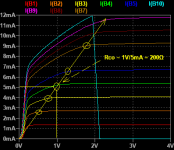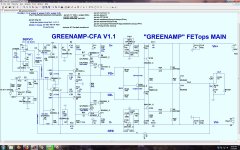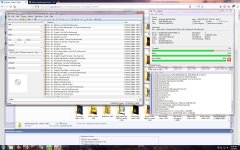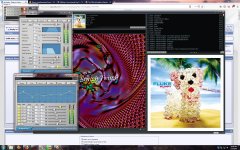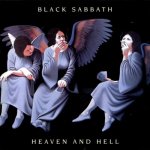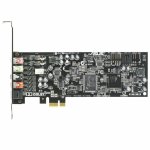The problem with SiC MOSFETs is that there are no P-channel versions... There were at one time, but I think Nelson Pass has them all?
One thing that slows the adoption of modern MOSFETs in general is the lack of P-devices and when a P-device is available it's often not very symmetrical.
Furthermore the new MOSFETs aren't optimized for crossover distortion. Audio MOSFETs are biased around where the subthreshold (BJT-like) region meets the square law region, which gives the best compromise in crossover distortion. MOSFETs designed for switching power supplies ignore this metric completely and so you are likely to have more crossover distortion and more H2 due to asymmetry.
One thing that slows the adoption of modern MOSFETs in general is the lack of P-devices and when a P-device is available it's often not very symmetrical.
Furthermore the new MOSFETs aren't optimized for crossover distortion. Audio MOSFETs are biased around where the subthreshold (BJT-like) region meets the square law region, which gives the best compromise in crossover distortion. MOSFETs designed for switching power supplies ignore this metric completely and so you are likely to have more crossover distortion and more H2 due to asymmetry.
The original KT-Cordell models have served many well here. Myself, VZaudio , many others. Predictable end projects.
Is not Quasi saturation...
Many aspects of the Cordell models are fine, no disrespect to Bob
It's the temperature variation that's faulty, and this shows up only in detailed temperature simulations that most people don't do.
There was a thread about this in the Software forum recently, easy to find.
It's not related to quasi-saturation, just happened to come up in the discussion with Keantoken because his q-s enhanced models coincidentally have the same fault.
@ Keantoken, few more notes.
VAR is set to 100 for both transistors, almost certainly a (bad) default.
VAR will inevitably be much lower than VAF -
for the 5200 VAF is 400 so VAR=100 may not be too bad
but for the 1943 VAF is only 80 so VAR=100 is surely off, maybe 20.
Usually not important for audio circuits but may as well be as realistic as possible.
I notice there is no QCO parameter in your quasi-saturation updates, this probably is important for accuracy.
Especially for simulations of stability, that I like to check quite carefully.
I see RCO is around 5 times RC, this seems physically plausible, you noticed any rule-of-thumb here?
Best wishes
David
Last edited:
As you stated those parameters are probably not important, hence why I didn't make more work for myself without having data.
Qco could be improved, sure. But with what data? Have you found a rule of thumb? Maybe if OStripper could probe the base current with a combination sine+square wave at the edge of clipping?
The upper quasi-saturation corner always falls on the yellow line shown in the picture, regardless of Beta, Gamma, Rc and the other parameters. So Rco is one of the parameters you can set early on.
Qco could be improved, sure. But with what data? Have you found a rule of thumb? Maybe if OStripper could probe the base current with a combination sine+square wave at the edge of clipping?
The upper quasi-saturation corner always falls on the yellow line shown in the picture, regardless of Beta, Gamma, Rc and the other parameters. So Rco is one of the parameters you can set early on.
Attachments
Maybe if OStripper could probe the base current with a combination sine+square wave at the edge of clipping?
What ... Sine/ square combo (define) , like what I have shown ?.
What base .... small signal or power transistor ?
OS
The problem with SiC MOSFETs is that there are no P-channel versions... There were at one time, but I think Nelson Pass has them all?
One thing that slows the adoption of modern MOSFETs in general is the lack of P-devices and when a P-device is available it's often not very symmetrical.
Furthermore the new MOSFETs aren't optimized for crossover distortion. Audio MOSFETs are biased around where the subthreshold (BJT-like) region meets the square law region, which gives the best compromise in crossover distortion. MOSFETs designed for switching power supplies ignore this metric completely and so you are likely to have more crossover distortion and more H2 due to asymmetry.
No SiC quasi - complimentary attempt ? (N-channel only for those who know not).
More H2 - some would fall in love with it. ha ha ...
What ... Sine/ square combo (define) , like what I have shown ?.
What base .... small signal or power transistor ?
OS
Say a small 200KHz square wave riding on a 10KHz sine wave. The square wave only needs to be large enough to get a clear trace of the base charging current. The current can be probed by using the scope in differential mode and probing across the base stopper. It should be a schematic with a close simulation, then I can adjust the parameters to get the same result.
I think quasi can be close to as good if not sometimes better than complimentary. It would be a good way to use N-only MOSFETs. But it does not eliminate the crossover distortion.
Also another problem is some of them have positive tempco up to high currents, so thermal runaway could occur.
As you stated those parameters are probably not important, hence why I didn't make more work for myself
If a parameter is less important then I don't take this as a reason not to fix it.
Rather it means I am satisfied to use a reasonable estimate, it's very little work and still far better than a bad default.
For an important parameter I would prefer measured data or else have less confidence in the simulation.
Qco could be improved, sure. But with what data? Have you found a rule of thumb?
It should be approximately proportional to CJC (QCO is in coulombs CJC is a capacitance in farads).
If there's about a volt across the junction then the numerical value will be about the same.
I have seen some data that is consistent with that, you have any data on this?
Rco is one of the parameters you can set early on.
Yes, my conclusion also.
Best wishes
David
I will take your word that the wrong parameters are a greater curse than attempting to fit a model without strong data. I will see what I can do with the models.
I will take your word...
Don't take my word, believe me😉
I still don't really understand QCO, it has just occurred to me that VTF also determines speed at low Vce.
Why do we need QCO, just a second break-point for better fit? Have you looked at this?
Best wishes
David
Last edited:
I think quasi can be close to as good if not sometimes better than complimentary. It would be a good way to use N-only MOSFETs. But it does not eliminate the crossover distortion.
Actually , I already have a quasicomp on the LT spice "burner". First amp
I made 10 years ago. Quasi-complementary Power Amps @ AmpsLab
Be a good learner to wrap a output stage error correction circuit around a few SiC's.
(Below 1).
Don't worry , I will get this stage to only add a few PPM to the golden CFA.
Looking at error correction "super TIS" article now. Lots of good stuff out in the wild.
(below 2)
Never pushed a Hitachi Helium He-4 hard drive to this max.
Simultaneously reading mp3 tags , streaming FLAC , and buffering to the BD-R burner. Off the same HDD.
Software is :
Mp3tag - the universal Tag Editor (ID3v2, MP4, OGG, FLAC, ...)
The Official ImgBurn Website
Some people don't know how to "tag" with jpg/correct info.
I use old Winamp (below 3) , in it's unofficial form (below 3).
DSP "city".
Have about 20K mp3's done , 60K more to go.
Then 50K FLAC's. Hard drives can die - music lives on in BD-R form.
Not the freakin' cloud !! 😡
PS - wish I could give the old BD-R's to somebody ( 10K FLAC/ 50K mp3)
OS
Attachments
Somebody's over here! Dio, what a voice he had, a rock tenor. Much of this thread is over my head, but it's been a fun and interesting read, following it and looking forward to the final product. This kind of collaboration is really great btw, alot of smart cookies around here!
Winamp, sort of the godfather of modern audio software. Haven't used it in forever, or maybe I have as so many other apps on built on it. Using Jriver these days, it's great, but not flawlwess, tagging and art collecting could be better, I had forgotten about Mp3tag, I'll have to try it again.
Somebody's over here! Dio, what a voice he had, a rock tenor. Much of this thread is over my head, but it's been a fun and interesting read, following it and looking forward to the final product. This kind of collaboration is really great btw, alot of smart cookies around here!
Dio , when he did the sabbath album ... Wow.
Yeah , smart cookies , oatmeal cookies , sugar cookies.
I'm just the "pitchfork villager". 😀
OS
Attachments
Winamp, sort of the godfather of modern audio software. Haven't used it in forever, or maybe I have as so many other apps on built on it. Using Jriver these days, it's great, but not flawlwess, tagging and art collecting could be better, I had forgotten about Mp3tag, I'll have to try it again.
I start with the flacs - then
Download TAudioConverter latest release
this converts fast to 320k lame mp3's , tags and all.
The only reasons I have mp3's -
-Slow network buffering is spotty for the flac codec.
The mp3 codec can do full file buffers -clients read from memory.
-Some material can not be found in FLAC.
I still have my old 200+ Real CD collection from 1999 ripped to 256K mp3.
But now I have it back in FLAC (plus much more).
A nice sound card is essential to run nice amps (below).
ASUS is real good , never any bloatware like creative ... based
on the CMI "oxygen" chipset. Use the generic CMI drivers from Taiwan.
PS - old godfather Winamp has the rock solid ASIO and (WAsapi) output
plugins , it can really make the most of a new powerful sound card.
192k bit-rates and all.
OS
Attachments
Last edited:
I'm using an HT Omega Claro Halo, it's also c-media based with an akm dac chip with upgradeded opamps. I have some bad memories of that bloated creative crap and thier "critical" updates, spent a weekend once reloading that operating system they call an app. P.O.S! Using wasapi, as asio caused occasional problems with switching to/between tracks and fade in fade out, havent tried it for a long time, but I don't want to fix what isn't broken. Will look into TAudioConverter, thanks.
I had read somewhere(?) that Flac was better for streaming over DLNA, error correction? I am still saddled with mostly mp3, as that is what is most widely available. I don't experience any difference in performance between the two. Flac rips take a little longer though.
I notice you renamed the 5200/1943 models. The -O is the Hfe grade, so it is part of the model number.
I notice you renamed the 5200/1943 models. The -O is the Hfe grade, so it is part of the model number.
I don't keep any models in LT's "BJT" bin. Everything is manual , I copy/paste
model #'s right out of the text files ... except standard diode and op-amp models.
.include is my way.
For my fancy Infineon schottkey's or VDMOS models , I just include Dadod's
.txt or my infineon text.
OS
I don't experience any difference in performance between the two.
Listen to a FLAC vs. MP3 with a system that can do 20-60Hz (Sub).
MP3 HF soundstage is compressed. Bass also loses "punch".
Global dynamic range , maybe ??
Blind , I could tell a youtube 128k vs. 320K lame vs. FLAC on a 20/30hz - 20khz
system.
FLAC's bass superiority was not evident to me until I received a real good
POLK 200W sub that could go <30hz.
This carries over to my amps , spooky and the newest ND CFA really have
bass "punch" , more than other designs. I suspect this is because of how they interact with
the back EMF of a large woofer.
OS
Last edited:
- Status
- Not open for further replies.
- Home
- Amplifiers
- Solid State
- GreenAmp ++ modulated Class G output
